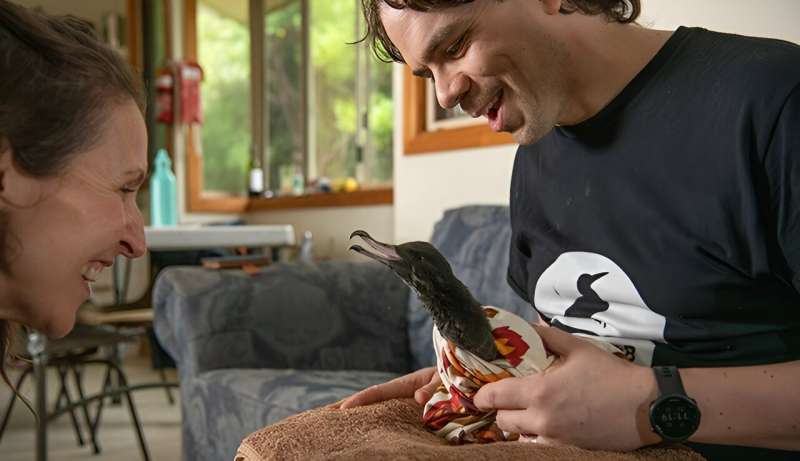
Researchers have proposed that the common name for the seabird the “flesh-footed shearwater” should be changed to sable shearwater in a bid to redress its racist origin.
There’s been an ongoing debate among biologists about the naming of species.
This has largely focused on animals and plants named after people who have done reprehensible things. So far, this has resulted in the American Ornithological Society committing to changing the common names for all bird species in North America that are named after people. Plant scientists are also making changes, having recently voted to set up a council to oversee and veto potentially offensive names going forward.
But the issue of naming species is not just restricted to those named for people who were racist or committed genocide. There are also some that might be named for particular slurs, or in the case of the flesh-footed shearwater, the color of their skin.
“The problem with the existing common name, the flesh-footed shearwater, is that it refers to the color of their feet, which are very white,” explains Dr. Alex Bond, Principal Curator in Charge of Birds at the Natural History Museum. “There’s been some debate about whether that’s what was intended, or whether the name was meant to mean ‘meaty.'”
“But I think it’s really quite clear from John Gould’s original 1844 description that he’s using it in the context of color. So that’s obviously problematic in much the same way that the Crayola crayon color ‘flesh’ was replaced in the 1960s or having plasters that are only one shade.”
For the past two decades, Alex and his colleague Dr. Jennifer Lavers have been studying these shearwaters—known scientifically as Ardenna carneipes—at one of their nesting colonies on Lord Howe Island, off the eastern coast of Australia. They have revealed that the birds are the most plastic-contaminated species in the world and consequently described the new disease plasticosis.
As a result of their long association with the birds, Alex and Jennifer have proposed changing the common name of the shearwater. But in doing so they came upon some hurdles, making the seabirds an interesting case study for the process of changing a name.
How to rename a species
When it comes to deciding on a new name, perhaps the most obvious place to start would be with where the bird comes from. But for migratory species like the shearwater this poses a problem.
“The default that I think a lot of people will go to is to pick an Indigenous name,” says Alex. “But the challenge for birds like the shearwaters is that they span hundreds of linguistic and cultural groups across two hemispheres. So where do you pick?”
One answer could have been to use the language spoken where the species’ largest breeding site is located. But for the flesh-footed shearwater, this is Lord Howe Island, which was never previously inhabited by any indigenous groups. Naming it after the island itself would have been equally problematic as it is named for a British naval officer.
The place where a specimen of this species was first collected was also ruled out. That was on St Alouarn Island, Western Australia, which is named after François de Saint Aloüarn, a French navigator who visited the Cape Leeuwin area in 1772 and claimed the region for France.
Another consideration that Alex and Jennifer took into account was the extra labor that science can put on the very communities they are trying to respect.
“There is a challenge of western scientists increasingly wanting to indigenize their science and putting a lot of burden on Indigenous communities and elders in particular,” says Alex. “Sometimes that’s moderated with financial compensation as people are paid for their time, but sometimes it isn’t.”
“You can’t just rock up and say, ‘tell me the Indigenous name for this thing!’ because that’s very extractive and that’s exactly what we’re trying to avoid.”
Instead, they decided to focus on its appearance. This raised another problem as there are multiple similar-looking species of shearwaters. Alex and Jennifer had to navigate around already existing common names including the pink-footed shearwater, Ardenna creatopus, and the sooty shearwater, Ardenna grisea.
As a result, they got a little more creative, settling on the sable shearwater. The name has a double meaning, referring not only to the birds’ dark black-brown plumage, but also the sandy substrate in which they nest.
While each situation will be different, Alex hopes that the case of the sable shearwater can be used to highlight the difficulties that can arise from renaming species, but also how they can be overcome.
Provided by
Natural History Museum
This story is republished courtesy of Natural History Museum. Read the original story here.
Citation:
Scientists propose changing bird’s problematic name (2024, September 6)
retrieved 6 September 2024
from https://phys.org/news/2024-09-scientists-bird-problematic.html
This document is subject to copyright. Apart from any fair dealing for the purpose of private study or research, no
part may be reproduced without the written permission. The content is provided for information purposes only.
